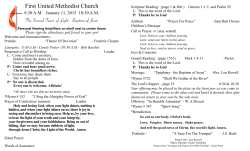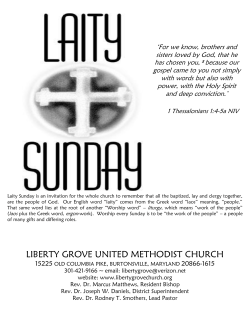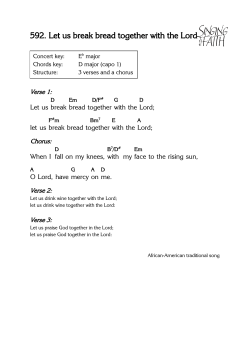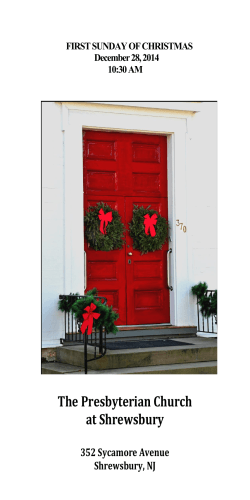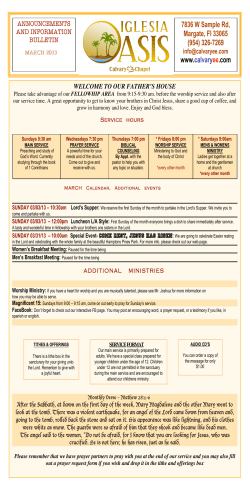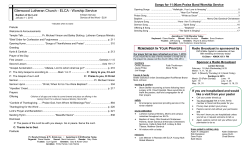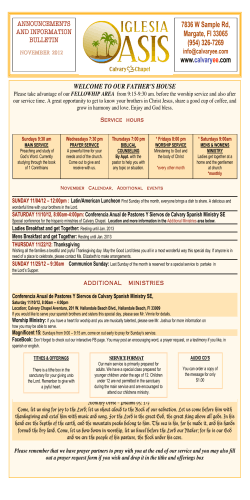
WORSHIP AND THE LORD`S SUPPER
WORSHIP AND THE LORD'S SUPPER
Gerald West
An architect by profession, Gerald West is a local church elder and chairman of the
executive committee of Partnership.
In Brethren churches there has always been a close connection between
worship and the celebration of the Lord's Supper. This connection is so
close that, for many Brethren, worship is virtually synonymous with the
Breaking of Bread. A description of Brethren practices and some
consideration of the historical circumstances that surrounded their origin
in the last century will help to explain the way their tradition was shaped
and formed.
BRETHREN AND THE LORD'S SUPPER
Many of the founders of the Brethren movement were ordained or
preparing for ordination. I They found themselves prevented by ecclesiastical tradition and denominational rigidities from sharing fellowship
with other believers and expressing this fellowship by breaking bread
together. Those contemplating missionary work found that, if not
ordained, they could even be prevented from breaking bread with the fruit
of their own evangelism. The Lord's Supper which should have been the
focus of Christian unity had become the occasion of division.
They wrestled with this problem, as many others have. As a result of
deep heart searching and a re-evaluation of the scriptures, they broke out
of their spiritual straightjacket on discovering that the New Testament did
not make the ordinance dependent on the presence of a validly ordained
individual. They could express Christian fellowship and be united ~~nd
the Lord's Table without waiting on any man for authority or recogmuon.
The necessary authority stemmed directly from the Lord's command and
recognition depended only on him.
The effect of this discovery was electrifying. They ~ere ab!e ~o .~eet
together from different denominational backgrounds wtthout inhibtUon.
53
54
DECLARE HIS GLORY
The sense of freedom and the release of spiritual power that flowed from
this discovery drew many to their gatherings. Having thrown aside the
restrictions of clerical ordination they acknowledged as far as their own
ministry was concerned that they exercised it 'on the nomination of my
Lord by his Spirit'.
It was a small step from this position to the rediscovery of the role of
spiritual gifts within the assembly. (They rejected, however, the use ofthe
ecstatic gifts which they came to regard as no longer available to the
church.) These spiritual gifts needed opportunity for their free exercise in
ministry and worship. Where more natural to exercise them but at the
Lord's Table?
The hallmarks of the early gatherings of Brethren were:
1 An open table-at which all believers in good standing were received.
2 The dismantling of clerical differentiations and freedom to break bread
together without requiring authority or authorised administration.
3 The abandoning of a liturgical approach to worship and the practice of open
worship associated with the Breaking of Bread.
The result was to establish a new pattern for gatherings of believers. It
has been the general practice of Brethren to meet each Sunday morning for
worship and the Breaking of Bread. The 'morning meeting' as it became
known, was and still remains, unique to assemblies of Brethren.z In the
morning meeting there was firmly established a close link between
worship and the Breaking of Bread. Although it would not be suggested
that corporate worship could not take place without breaking bread, this
ordinance is undoubtedly seen as the normal, natural and primary context
for the worship of the assembled church.
NEW TESTAMENT PRACTICE
Brethren would undoubtedly contend that their practice reflects the
emphasis of the New Testament church. One must ask, however, to what
extent this connection between worship and the Lord's Supper is
supported by New Testament practice. A study of this question throws
light on the ordinance itself and suggests appropriate contexts for its
celebration.
In four verses in 1 Corinthians, Paul describes a simple series of actions
and words of the Lord Jesus at the Last Supper (11 :23-26). The ordinance
which these verses describe has been given a number of names including
Holy Communion, The Eucharist, the Lord's Supper and the Breaking of
Bread. Brethren have typically referred to it by the last two of these, the
Lord's Supper and the Breaking of Bread. All of these names have a basis
WORSHIP AND THE LORD'S SUPPER
55
in the New Testament or in the ordinance itself. (See Acts 2:42; 1 Cor
10:16, 21; 11:20, 24.)
'The Breaking of Bread' and its equivalent 'to break bread' are
interesting ~erms. I.t is not always clear that they refer necessarily or only
to the ordmance Itself. They occur a number of times in the New
Testament, and are the most frequent designation for the ordinance. The
slight uncertainty of reference is a reminder that the early church seems
frequently and perhaps typically to have 'broken bread' in the context of a
communal meal (see Acts 2:42; 20:7; 1 Cor 11:20-34). There is a similar
breadth of reference in the single New Testament usage of the term 'The
Lord's Supper' which encompasses the common meal within which the
Corinthians celebrated the ordinance (1 Cor 11:20).
This conjunction of the ordinance with a meal is a reflection of the
original circumstances in which the ordinance was instituted. The Last
Supper was the final occasion before his death on which the Lord Jesus
spent an evening with the disciples and shared a meal with them.
The Last Supper was not simply an opportunity for fellowship with
close associates. It was also a Passover meal. It combined a formal meal
with a structured religious liturgy including elements of worship. The
courses of the meal-were interspersed with prayers, thanksgiving and
praise, singing and the recitation and exposition of scripture.
This ordered sequence had a number of purposes. The whole meal was
in part a re-enactment of the original circumstances of the Passover. It was
c!t:signed to remind the participants of God's saving acts when he brought
their forefathers out of Egypt and as a result of which they became his
people. The specifically religious elements provided an opportunity for a
response of praise and worship to the remembrance of what God had done
in the past. The ceremony was designed to educate all those present, and
especially children, in the significance of the meal.
The Passover was celebrated nationally in Jerusalem. The lamb was
ritually slaughtered in the temple, but the meal and its associated
ceremonies were not part of the temple worship. These were celebrated in
small groups usually within the extended family. In this intimate circle the
formality of the occasion was considerably softened. Even a cursory
reading of the gospel accounts show that the Last Supper shared this
informal character. Little of the Passover ritual remains in the record but
the intimate atmosphere is made abundantly clear especially in John's
Gospel. The circumstances of the foot washing; the questioning and
conversations; the Lord's extended but intensely personal instruction of
his disciples: all graphically depic an intimate occasion. Twice during the
evening, first towards the beginning of the meal, and then at. the. en~, our
Lord departed from the normal course of events and in so domg mstltuted
what we now recognise as a single ordinance.
56
DECLARE HIS GLORY
The apostles continued, after the ascension, the table fellowship they
had experienced with the Lord both before his crucifixion and after his
resurrection. The special importance of what he had done at the Last
Supper was quickly recognised. His command to repeat it was obeyed and
observed, probably daily (Acts 2:42, 46). There could be nothing more
natural than to remember him by breaking bread as they enjoyed table
fellowship together. This was made especially easy as they were
continuing the communal life they had enjoyed together for the past few
years. Under these circumstances it was also natural that, under the
guidance of the apostles, the table fellowship of the early Jerusalem church
should follow the pattern of the Last Supper and be accompanied by
prayer, praise, teaching from Scripture and holy conversation (Acts 2:42).
This immediate practice seems to have been modified later by the
circumstances of time and place. With the recognition of the first day of
the week as the regular occasion for Christian gatherings, the celebration
of the ordinance probably became a weekly occurrence, but the character
of the gatherings continued, combining a fellowship meal, the Breaking of
Bread, worship and Christian instruction (Acts 20:7-12). Such gatherings
provided the opportunity for many of the New Testament letters to be
first read to the assembled believers to whom they were addressed.
Although one cannot be certain how the gathering described in
1 Corinthians 14 was related to the supper described in 1 Corinthians 11,
there is every reason to suppose that it formed part of the same gathering.
It is perhaps relevant that the gifts of prayer and prophecy which are
discussed in the verses in chapter 11 immediately prior to the discussion of
the supper are also the principal gifts discussed in chapter 14. The exercise
of spiritual gifts would be both natural and appropriate at such a gathering
and some of the comments in chapter 14 are particularly relevant to the
Breaking of Bread (nb vv 16--17). In view of the general practice it seems
probable that they were part of the gathering referred to generally by the
apostle by the repeated phrase 'when you come together'. (1 Cor 11: 17,
18, 20, 33, 34; 14:19, 23, 26).
Within the period covered by the New Testament, one can see some
signs of modifications in this practice. Reference has already been made to
a change from daily to weekly observance. An important development was
the bringing together of the two parts of the ordinance-the bread and the
cup. At the Last Supper these had been separated by most of the Passover
meal. Having been brought together, the ordinance became a distinct part
of the fellowship meal. From Paul's description of the ordinance it would
seem that this had already happened by the time of Paul's conversion and
certainly by the time of his arrival in Corinth and the beginning of his
mission there (1 Cor 11:23). Later, in sub-apostolic times, the fellowship
meal became separated from the ordinance altogether. This was perhaps
WORSHIP AND THE LORD'S SUPPER
57
due in part to the type of abuse which Paul seeks to correct in his letter to
the Corinthians (1 Cor 11:20, 22, 34).
There were some occasions when believers came together for a
particular purpose as, for example, when they met to pray regarding the
crisis arising from the imprisonment of Peter and John (Acts 12:5,12). But
the general impression is that, in New Testament times, there was no clear
distinction by time or place between fellowship at a common meal,
breaking bread, praise and worship and teaching. The emphasis is upon a
synthesis of spiritual exercise at a single gathering rather than the
segregation which subsequently became typical.
THE SUPPER AND WORSHIP
New Testament practice shows a close association between the Lord's
Supper and the various other expressions of the corporate life of the
church, including worship. Brethren practice was formed and moulded by
historical circumstances seen in the light of New Testament practice. If
the ordinance is considered in this light, one can establish whether the
conjunction of worship and the Lord's Supper is a casual connection or
whether it derives from the character of the ordinance itself. If the latter is
true, the ordinance will influence the character of the worship with which
it is associated. One can also consider whether there are features of the
Lord's Supper which make it particularly appropriate as a context for
corporate worship.
There are undoubtedly a number of aspects of the Lord's Supper which
make it a powerful stimulus to the corporate worship of the church. Paul's
account in 1 Corinthians 11 records that, on two occasions, before the
bread was broken and before the cup was drunk, our Lord gave thanks.
Embedded within the ordinance, therefore, is a twice repeated expression
of thanksgiving to God (Mark 14:22-23). This may have been understood
initially by the disciples in part as thanks for the provision in God's
providence of the bread and wine. But in retrospect it was quickly
perceived to have a deeper significance. The meaning of the loaf and cup
are clearly expressed in the words of institution. It is the understanding of
this meaning by believers which results in thanksgiving.
Such thanksgiving follows the examples of the Lord himself. It is made
mandatory by his injunction 'do this' and it is found at the very centre of
the ordinance. The broken bread and poured out cup, which speak so
eloquently of the sacrifical death of the Lord for his people, are placed
firmly in a setting of praise and thanksgiving. So important was this seen
to be that in the early centuries of the church the ordinance was called
'The Thanksgiving' ('The Eucharist'). Any setting of the Lord's Supper
58
DECLARE HIS GLORY
which ignores this truth seriously distorts the ordinance. Following our
Lord's example, we bring our thanksgiving to the Father for the person
and work ofthe Son. This is only possible as we come in the fullness ofthe
Holy Spirit (Eph 4: 18-20).
The ordinance is not simply a stimulus to private thanksgiving. It is
essentially a communal act which cannot be celebrated by an individual
believer. It brings believers together. The loaf must be broken, the cup
poured out, and both shared among the assembled company. To take is to
share with and to identify oneself with both the Lord and the other
believers present. To break bread is a symbol of fellowship and is an act
expressing the presence and reality of the local church.
The ordinance is not only a corporate act. It is also intended to be a
public act. Paul says that it is a declaration and proclamation of the
essential Christian gospel. He writes, 'as often as you eat the bread and
drink the cup you proclaim the Lord's death' (1 Cor 11:26). We proclaim
his death not simply as a fact of history. The ordinance makes clear its
vicarious nature, its saving power, and that we are the grateful recipients
in Christ of his salvation. Peter asserts that the role of the Lord's people is
to be a worshipping people and that they fulfil that function by declaring
his wonderful deeds (1 Pet 2:29). The proclamation of God's saving acts is
an essential element of worship. If to break bread together is to make such
a declaration, then it is also to engage in an act of worship. Furthermore,
in this action the church expresses its purpose and fulfills its highest
calling.
The proclamation is not confined to a statement regarding the Lord's
death. Paul writes, 'you proclaim the Lord's death until He comes'. The
clear implication is that an essential part of the proclamation is the
assertion of his resurrection, present exaltation and future return. The
bread and wine remind the believer of a living Lord Jesus. The bread
which we break is a communion with a living and life-giving Lord (1 Cor
10: 16). The Lord who is proclaimed is the one who declares of himself, 'I
am the Living One: I was dead, and behold I am alive for ever and ever!'
(Rev 1:18).
There are a number of New Testament indications that pomt to the
Lord's Supper as providing in some way a revelation of Christ to the
believer. The Lord himself promised that when two or three are gathered
together in his name he would be present with them (Mark 18:20). No one
can doubt that this promise applies to a gathering of the Lord's people
around his table. He commanded us to do this 'in remembrance of me'.
(1 Cor 11:24-25). Faithful obedience to that command in the company of
the Lord's people brings him powerfully before the mind's eye.
The Pauline comment 'until he comes' is a reminder of a joyful and
blessed expectation. The atmosphere of thanksgiving and joy to which
WORSHIP AND THE LORD'S SUPPER
59
reference has already been made is consistent with the fact that this is 'The
Lord's Supper'-a feast. It sprang from a feast and it points forward to a
feast .. Indeed the supper is, in a measure, an anticipation ofthat longed for
occasiOn.
As we look forward to his coming again and anticipate the joy of the
heavenly supper, we also remember that he is present at the feast as the
host.
What food luxurious loads the board
When at his table sits the Lord.
The wine how rich, the bread how sweet
When Jesus deigns the guests to meet.3
When believers come together as the body of Christ around his table
and fulfil their divinely appointed role in the power of the Holy Spirit, it is
not surprising that he becomes manifest. If the presence of God is manifest
to an unbeliever when believers assemble, it is to be expected that
believers themselves will be powerfully aware of the presence of their Lord
(1 Cor 14:25). Worship is the natural response of the redeemed soul to the
presence of the redeemer. Surely those who break bread in accordance
with the Lord's command and who find him present with them will fall
down in worship and adoration.
In all these ways breaking bread is a powerful stimulus to worship. At
its centre is thanksgiving and joy. The bread and cup testify to the saving
acts from which we personally benefit and for which we give thanks. The
act itself is an act of worship which fulfills the divinely ordained role for
the church. In fulfilling this role the assembly becomes the vehicle for a
revelation of the Lord to itself and to the world.
In view of the powerful theological character of the Lord's Supper one
would expect any activity of the church which is brought into close
relationship with it to be strongly influenced both as to content and
conduct. That this is indeed so can be seen from the apostle's discussion of
the way in which the Corinthian assembly conducted the fellowship meal
which they associated with the Breaking of Bread (1 Cor 11:20-34). So
inappropriate was their behaviour that the apostle could comment, 'it is
not the Lord's Supper that you eat' (v 20). A number of general lessons
can be drawn from this passage and applied to worship in the context of
the Lord's Supper.
There is a distinction between corporate and personal worship ~hich
needs to be clearly understood. Corporate worship is ~ot S;'lllply
simultaneous personal worship where each individual worships. Wl~hout
intelligent interaction with the others present. Corporate ~o~hip lS ~e
worship of the body as a body. Unity of thought and express.lOn m worship
is achieved, not by an imposed liturgy but by the mtelligent and free
60
DECLARE HIS GLORY
expression of the individual members of the body exercising their gifts in
the fullness of the Spirit and interacting with one another and with the
whole church.
Worship so generated expresses the corporate nature of the church as a
free association of individual members bound together by a common bond
with their head and upbuilding themselves in a common life. Such
worship will have a greater scope and depth than the personal worship of a
single individual. The breath of understanding and experience of the Lord
possessed by the whole church is available to inform and enrich the
worship. This can be brought to bear by the Spirit using all the gifts
available. This is of course only possible where there is freedom for the
exercise of these gifts. It is this added scope and depth to worship which
makes 'the morning meeting', at its best, a treasured experience for those
who worship in Brethren churches.
The character of the ordinance set limits for the Corinthian church to
the character of the meal with which it was associated. The ordinance
performed a controlling function (vv 21, 22, 33). If this was ignored, there
was a serious danger of destroying the ordinance (v 20). It ceased to be a
meaningful celebration. Similarly, breaking bread performs an important
controlling function on any associated worship. It does this by focusing
the worship and by providing limiting boundaries for it. This is
particularly important where the worship is open and liberty can easily be
abused. It focuses the worship by bringing the attention of the assembled
church to the meaning of the ordinance itself and by the necessity to
perform the acts which constitute the ordinance. It sets a boundary to the
worship by excluding anything which cannot be encompassed within the
meaning and purpose of the ordinance.
However, it is essential to identify carefully the focal point and where
the boundary lies. The Lord Jesus made his intention quite clear when he
said, 'Do this in remembrance of me.' The ordinance is to be celebrated in
remembrance of him; the bread is to be broken and eaten in remembrance
of him. The cup is to be drunk in remembrance of him. There is no
qualification or restriction in these words. It is the fullness of the person
and work of Christ that is the object of remembrance and it is the fullness
of the person and work of Christ that is the subject of Christian worship.
There is no restriction of topic or time-so long as it is related to
Christ-who is the eternal word, the alpha and omega; in whom, through
whom and for whom all things were created; and who is the beginning, the
first born from the dead, that in everything he might be pre-eminent.
(John 1:1-3; Rev 1:17; Col 1:16--18). The person and work of the Lord
Jesus Christ provide the whole subject matter of Christian worship and it
is this upon which the attention of worshipping believers is concentrated.
With such a restriction there is an endless source of inspiration for true
WORSHIP AND THE LORD'S SUPPER
61
worship and there is a constantly renewed source of freshness. His riches
are unsearchable and his praise eternal.
Amongst some Brethren there is a feeling that the worship associated
with the Lord's Supper should be more restricted than this and should
concentrate on the death of our Lord. They feel that other aspects of truth
should be excluded from worship on such an occasion. This attitude
which can express itself in positively disruptive ways, involves ~
misunderstanding of the ordinance itself and a serious diminishing of the
person of our Lord. We come to remember him. And as we remember him
it is the living Christ who is present. We cannot deny the cross but we
must not restrict our remembrance of him to such a narrow compass.
Those who fear that without this restriction the worship of the church will
lack focus do not take proper account of the influence of the ordinance
itself. There is no doubt that worship, when associated with breaking
bread, is inevitably focused on the person and work of the Lord Jesus.
This is all the restriction that is necessary.
Nevertheless, when we come together, the Spirit often does direct the
thoughts of the church to some particular aspect of his person and work.
Such a theme is to be treated with respect, but it is important not to
become bound by the idea that there must be a theme. If there is a theme it
should develop as the occasion proceeds and should result in the
expression of thanksgiving and praise. This in itself is a liberating
ministry.
Both New Testament practice and the theological meaning of the Lord's
Supper confirm that worship is necessarily associated with the Breaking of
Bread. Such worship must reflect the corporate nature of the church as the
body of Christ. To this extent scripture supports the Brethren tradition.
But, as other essays in this review show, this is not to say that worship is to
be confined to what takes place around the Lord's Table.
Footnotes
1 See F Roy Coad, A History of the Brethren Movement (Paternoster Press 1968)
15-35.
2 For a· description of a morning meeting see: Peter Cousins, The Brethren.
Christian Denominations Series. (The Religious Education Press 1982).
3 From the hymn 'Amidst us our Beloved stands' by CH Spurgeon.
© Copyright 2025
